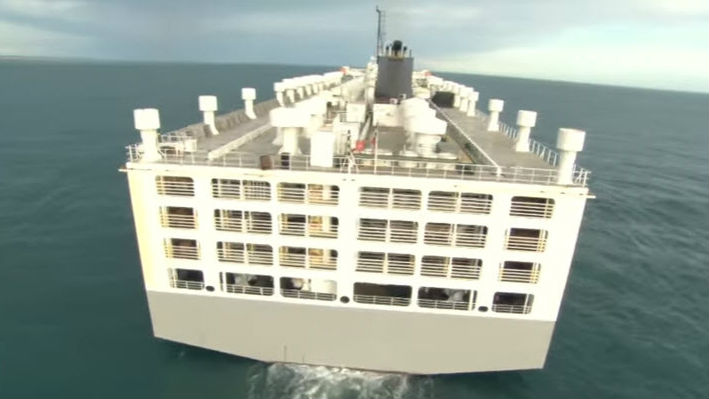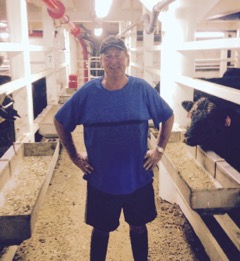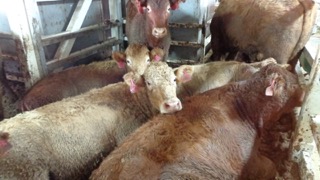Live Export: Designing Ships for Animals

Australia’s live export trade has come into the spotlight with two recent articles on the impact of ship design and operation on animal welfare and on the risks of mass heat stress animal deaths at sea. MarEx spoke to Dr Peter Arnold, a veterinarian with 50 years’ experience in the live export industry, to find out his views on the industry.
 Do you see problems in how the live export trade is reported?
Do you see problems in how the live export trade is reported?
Recent media reports have highlighted some of the challenges that face the live animal export industry worldwide including mass deaths from heat stress. The problem is that they don’t say that most of these vessels have been banned from the Australian waters, as they don’t meet Australian Maritime Safety Authority (AMSA) standards. What is interesting is that it is not the livestock transport industry that is the problem, but the way it is done and by whom.
If the industry is conducted within the rules and regulations set out in Australia by AMSA, the various animal welfare agencies, along with the recommendation and best practice guidelines set out by the Australian Livestock Exporters’ Council, then the industry seems to run well, extremely well in fact. We never read about the 98 percent successful events that occur on a daily basis and for the last 30 years.
I want to clearly state 98 percent of voyages from Australia are very successful and comply with ethical standards and expectations. About two percent don’t, and of those 50 percent can be easily ‘fixed’ by proper management, applying animal husbandry and welfare principles.
The thought of a large number of animals at sea dying of heat stress is seen as disturbing by many people. What is your perspective on that?
On my last voyage to Russia, aboard the MV Nada, we travelled through the Great Australian Bight in force 4 gales and through the Straits of Hormuz with extremely high temperatures and humidity in May/June. Of the 17,499 head of Angus cattle, approximately 2,500 were pregnant, 23 died, most from misadventure (fighting, heads stuck under rails during deck curfews) and four females aborted.
I could have photographed these, and highlighted the decomposing bodies trampled overnight by the others in the pen, with skin off and frothing from the mouth. I could have lined up the four aborted foetuses side by side and sent this photograph around the world.
These deaths were true, but the reality was different, 17,499 cattle arrived live, well and with an overall weight gain. Most of the approximately 2,500 pregnant Angus heifers and cows didn’t abort, and I am sure calved happily on Russian farms a few months later.
 That was the reality. It’s hard to calculate the benefit this voyage had for all those involved from bankers, suppliers, fodder manufactures, shipping personal, exporters, importers, Russian farmers and the ultimate consumers.
That was the reality. It’s hard to calculate the benefit this voyage had for all those involved from bankers, suppliers, fodder manufactures, shipping personal, exporters, importers, Russian farmers and the ultimate consumers.
Are there operational problems that need addressing in the industry?
There are areas and seasons in the world, where and when we must take great care when we travel through them with animals aboard, for example, the Somali Straits, the Straits of Hormuz, the Red Sea and the Persian Gulf. The weather and humidity can be stifling and life threatening.
If a ship is travelling through these areas during the northern summer, the operator should:
• decrease the loading density of the pen, spread the animals out or don’t load to capacity.
• zig zag the course so that the envelop of humid air is always dispersed
• pass by at night.
• don’t take unsuitable animals, for example Bos taurus cattle or British breed sheep
• use ships with adequate ventilation, and supplement it where possible with external fans or air vanes or open ramp doors
• Above all, plan the trip and the time of arrival in these areas.
Can you tell us about some of the problems you see with the design of livestock carriers?
I initially accompanied around 20,000 sheep from Perth, Western Australia, to Bandar Shapor in Iran back in 1972/3. I sailed two or three voyages on a vessel that was a converted old passenger ship, with the below decks areas, ripped out and replaced by odd-shaped pens that would hold various numbers of sheep.
The construction was all about the area that could be converted to hold animals and nothing to do with the animal’s welfare or comfort. Ventilation was a secondary thought and designed to fit the spots rather than the volume of air changes per minute.
It was on this voyage that I saw that the actual animal husbandry needed to be adapted to the pen design and the positioning of the pens throughout the ship. The industry was demanding that the sheep adapt to ship design. This would always create bad out comes, and did and is still creating bad out comes today. Obviously not on this vessel, but many so called modern animal carriers that class themselves as world class.
 Many ships have funny-shaped pens. On this ship there was one constructed in a below deck laundry and passenger store room with one or two port holes. The number of sheep allocated to those pens, say 10 head, corresponded to the metric measurement allowed by AMSA guidelines and rules. However, this was wrong for the animals. Its true capacity, despite fitting the AMSA recommendations, was wrong and should only have been four head. Thus the loading of that pen was out by numbers greater than 50 percent. Yet all involved had followed the rules.
Many ships have funny-shaped pens. On this ship there was one constructed in a below deck laundry and passenger store room with one or two port holes. The number of sheep allocated to those pens, say 10 head, corresponded to the metric measurement allowed by AMSA guidelines and rules. However, this was wrong for the animals. Its true capacity, despite fitting the AMSA recommendations, was wrong and should only have been four head. Thus the loading of that pen was out by numbers greater than 50 percent. Yet all involved had followed the rules.
The sheep suffered, and the outcomes were poor. If you have one too many sheep in a pen of 20 sheep, it’s not one sheep affected but 21 sheep affected or stressed.
I realised that the sheep required some basic comfort and survival requirements. I applied the simplest of animal husbandry principles to the situation I was in.
These were broken down to extremely simple requirements: food, water, air, space and protection. I then proceeded to analyse each pen on its merits. It was pointless allowing 10 sheep in a pen that fitted the space allocation rules, when there was air sufficient for four head only. We then analysed all the pens and loaded them accordingly.
On the comical side, we obviously had then too many sheep for the pens available. The extra sheep were allowed to roam the ship and seek their own comfort places. They went everywhere, from empty swimming pools to deserted bars, promenade decks and stairs. The sheep worked it out. We then supplied them with food and water, and the voyage was quite successful.
Have things changed now?
I must admit, little has changed today. Modern, so called, well designed ships are commissioned today, claimed as the world’s best and most modern, yet still make the exact same mistakes as they did 30 years ago: shipping not sheeping.
I will give you some examples: An essential part of a livestock ship design is ventilation for the animals. The regulations often demand volume changes per minute. A great theory, and many ships pride themselves by exceeding the required air volume changes per minute.
Nobody has asked the animal what it requires. This asking can be done by observing and measuring. Firstly, animals breathe and cool by passing air through their nose and mouth. The blatantly obvious place to provide this air is at head height, wherever their heads may be in the pen.
Most air condition vents on ships run in straight lines, usually following passage ways or down the inside of pens above a fence line, as it is easier to engineer. In reality, the sheep would prefer the air vents at a few centimetres above their heads and crossing the pens in divisions of sheep body lengths, simply divide the pens cross ways with ventilation shafts one to two metres apart.
Most design is about the ship and not the sheep. Even placing ventilation outlets in the middle of the pen delivering air at head height is better than delivering air in the alleyways.
 You have highlighted that many animals gain weight during their voyage. Are there any issues related to vessel design and animal feeding?
You have highlighted that many animals gain weight during their voyage. Are there any issues related to vessel design and animal feeding?
Food and water is supplied usually along the alleyways, alternating food or water troughs, or food one side and water the other. This is done for ship design, not sheep requirements. It’s easier to have water pipes running down a line with tap outlets every so often. Automated feed supply chains are exactly the same. It looks good, and it’s practical from an engineer’s point of view.
However, it’s not what a sheep wants. A sheep wants the food as near as possible to him.
In a square pen where is the closest spot for a sheep to access food at all times? Obviously it is in the middle, yet they are on the outside, usually on one side only, i.e. food one side water the other. Most pens are rectangular and the trough placement is more irregular. If you place the food in the middle of the sheep they will get better access.
The food supplied is usually in the cube form, initially designed for pigs and chickens. These were the first animals to be automatically feed by machines. Both these animals have one stomach, digesting high protein, high starch and low fibre.
The live shipping animal, sheep, goats and cattle, are ruminants with four stomachs, two acting as fermentation vats. These animals rely on converting cellulose (grasses, dry or moist) to starches then sugars and acids. They get their protein, not from the diet, but the bacteria in their fermentation vats.
Ship engineers and designers usually don’t understand that. They want a pellet, cube or food pack to be loaded on a ship, then transported throughout the ship and easily delivered to a site - the trough in the alleyway, not the centre of the pen.
They also want this food to be solid in structure, dust-free, non-flammable, stored and re-usable for the next voyage. In other words, strongly built for storage and transport without regard for digestibility and fibre and thus never designed for a sheep’s nutritional requirements. Sheep want roughage and little but adequate, starch and protein, but roughage makes bad sheep pellets.
Has this industry ever heard of liquid feeding and supplementation? The fat lamb industry in the U.S. continually supplement their lot-fed fat lambs with liquid feeding, why not the shipping industry?
Ideally, and it did happen a few years ago, a company made little match box bales of hay, compressed to withstand the transporting needs of the ships, which were ideal or better than the previous cube or pellet. This mini hay cube was rejected by the shipping companies because of too much wastage, thus too much litter on the floor and thus doubling the cleaning time for the vessel. Again, was the benefit for the sheep or the ship?
So here we have another example of our modern ships being designed for convenience and not the cargo. There is an old industry saying: “If the animals were worth their weight in gold, they would all arrive safely.”
How could ship design be altered?
There are literally hundreds of design features on ships that could easily be fixed by designers and engineers to suit the animal first and foremost and still fit into marine design and safety.
Many years ago, I was asked to go to Papenburg, Germany, by Wesfarmers, to look over the construction of a new sheep ship, the Corriedale Express. On arrival, I was taken over the vessel and left to wander around for several days. Prior to leaving, the engineers and ship designers had a meeting to discuss the beautiful and most modern sheep ship in the world.
I went through the many design faults and the practical changes that could immediately be fixed prior to delivery next month. They um'd and ah’d and did very little, claiming that they had previously built and designed many others, and basically, I didn’t know what I was on about. These were the early Livestock Express ships, designed for European short haul voyages with European cattle. They were the best, and this ship was the most modern.
However, I said to them the ship was one of the poorest designed sheep ships. It had been designed solely on historical designs of European cattle carriers. Yet it was to run between Australia and the Middle East, with the extremes of climatic conditions being experienced every voyage. The cargo to be carried was not of European style or temperament, mostly sheep and not cattle.
They didn’t like that, and I was quickly dispatched back to Australia.
I was then at the launching and the first loading of this vessel in Adelaide South Australia, where most of the problems discussed arose as anticipated. It was not because I was being overly clever, but because I had had the ship and animal experience before with the Kuwait sheep ship constructions. It wasn’t a matter of “I told you so” but now, and in the future, we will have a problem for over 20 years while working with this vessel. It could have easily been better designed from the first day.
Is there anything else you would like to say?
The live animal shipping industry is a good industry which could be improved easily, insuring better outcomes for sheep and shippers, by close consultation and control, being in the hands of animal husbandry people, not accountants and mariners.
The opinions expressed herein are the author's and not necessarily those of The Maritime Executive.
